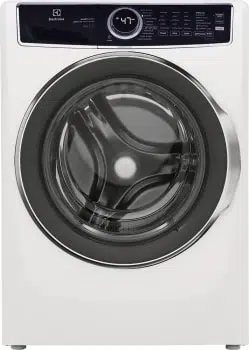Documents: Go to download!
User Manual
- User Manual - (English, French, Spanish)
- Quick Start Guide - (English)
- Use & Care Guide - (English)
- Energy Guide - (English)
- Installation Guide - (English)
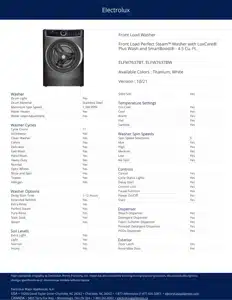
User manual Washer
CONTROLS AND SETTINGS
Model series
300 SERIES

400 SERIES

500 SERIES

600 SERIES

1 power
2 cycle selector
3 LED display
4 temperature
5 soil level
6 spin speed
See other models: ELFW7637BT ELFG7637BW ELFE7637BW ELFE7637AT ELFE7637BT
7 options
8 set/select
9 cancel
10 start
11 PODS® (select models)
Cycle selection
Press the power button to turn on the unit. Then, turn the cycle selector in either direction or press the cycles button (dependent on model) to scroll to the desired cycle. The indicator light for that cycle will be illuminated.
The estimated cycle time will appear on the LED display and indicator lights adjacent to the default settings (water temperature, final spin speed, and soil level) will illuminate for the cycle selected. See Washer Settings Chart for default settings for each cycle.
Cycle settings and cycle options can be changed using the temp, spin and soil buttons. See Cycle Settings and Cycle Options for detailed directions and descriptions of available settings.
To change the cycle once the cycle has begun, press cancel, select a new cycle, and press start again.
NOTE Turning the cycle selector knob without canceling the cycle first, will not change the cycle.
To stop the cycle, press cancel.
NOTE Using PODS® setting may increase fast wash time by several minutes.
NOTE
- For spin only cycle deselect extra rinse. For drain only cycle select no spin.
- See Cycle Options for rinse options and Cycle Settings for spin settings.
Cycles
| LOAD | LOAD TYPE | CYCLE DESCRIPTION |
| OPTIC WHITES | White loads |
• SmartBoost action • longer agitation • optimized temperatures |
| WHITEST WHITES | White loads |
• longer agitation • higher temperatures |
| WHITES | White loads | • longer agitation |
| HEAVY DUT | Large heavily soiled loads |
• longer agitation • aggressive cleaning motion • higher temperatures |
| NORMAL | Mixed loads, cotton |
• moderate agitation • moderate cleaning motion • most energy efficient |
| ACTIVEWEAR | Highly solid lightweight synthetic apparel |
• longer agitation • mild cleaning motion • extra rinse |
| COLORS | Lightly soiled dark or dyed fabrics |
• mild cleaning motion • lower temperatures |
| TOWELS | Towels |
• long agitation • higher temperatures |
|
FAST WASH (varies by model) 15/18/20 min. |
Small lightly soiled loads (3-5 pieces) |
• aggressive cleaning motion • extra rinse |
| DELICATES | Small lightly soiled loads (delicate fabrics) |
• shorter agitation • gentle cleaning motion • lower temperatures • lower spin speeds |
| HAND WASH | Small, lightly soiled loads and very delicate fabrics |
• very short agitation • long soaking times • lower temps • lower spin speeds |
| RINSE & SPIN | Rinse and spin only (cold rinse or add fabric softener) | • cold temperature |
| CLEAN WASHER | See “Care and Cleaning” section of the manual | |
*All cycles not available on every model. See Page 19.
Cycle settings
Washing temperature
The appropriate washing temperature will automatically be indicated for the cycle selected. To change the preset temperature, press the temp button to scroll to the desired setting. Select a wash water temperature according to fiber content, colorfastness and soil level.
To protect your fabrics, not all temperatures are available with every cycle. If a temperature is not appropriate for the cycle, it cannot be selected and will not be lit by pressing the temp button.
The temperature selected for the cycle will be remembered and recalled each time that cycle is selected in the future.
All wash water temperatures are automatically regulated to maximize detergent effectiveness and improve washing performance. The water heater setting and its distance from the washer, water usage in other parts of the home, and seasonally low ground water temperature in some geographic areas can affect water temperature.
Soil level
Adjust the wash time based on the soil level of each load. Solid soil (on select models), heavy, normal, light and extra light (on some models) soil levels are available.
Spin speed
Max (on select models), high, medium and low (on some models) spin speeds are available for each cycle. The spin speed and/or duration of final spin vary from model to model and cycle to cycle.
Increasing the spin speed will extract more water, decrease drying time and conserve energy. Decreasing the spin speed will reduce wrinkling.
Select low spin speed (on some models) to gently spin items that should be line dried.
Use no spin to omit the final spin at the end of the cycle. The load will be very wet. Remove items from the wash drum to drip dry or select a spin only cycle to remove excess water at a more convenient time.
Cycle options
The default options for each cycle will automatically be chosen when a cycle is selected. To protect fabrics, not all options are available for all cycles. If an option is not available for a cycle, the indicator will not light.
Selecting options
Press the option button to scroll though the options until the indicator light for the desired option flashes, then press select. The indicator light will illuminate when the option has been selected. Follow the same steps to deselect an option. The indicator light will turn off when the option is deselected.

NOTE If changes to the settings or options are attempted after the cycle starts, you will hear several beeps when the buttons are pressed. To change settings or options, press start/pause, make the new selections and press start/pause again.
All settings or options selected for the cycle, except sanitize (on select models), perfect steamTM (on select models), and stain treatment options, will be remembered and recalled each time that cycle is selected in the future. To return to factory settings, press and hold soil and options buttons at the same time and hold for 3 seconds until the confirmation signal sounds. To prevent unintentional and accidental exposure of delicate material to excess heat or unexpected steam, the sanitize, perfect steamTM and all stain treatment options will need to be reselected each time.
Stain treatment options (on select models)
Your washer is equipped with powerful stain treatment tools. Depending on your model, use one of the options below to deal with tough stains on your garments. See step 5 in the Operating Your Washer section in this manual for details on adding stain additives to the dispenser.
StainTreat (400 series washer)
Select this option to add a short initial wash period to available cycles using the stain treatment additives in the stain soak/treat compartment. After the stain wash phase, the load will automatically advance to the main wash cycle.
StainTreatII (500 series washer)
Select this option when available and rotate the cycle selector to rotate through the stain types below. Stain treatment and main detergent will recirculate in the agitating load for approximately 20 minutes and then the washer will advance to the main wash cycle.
- Any Stain

Recirculating wash solution will be heated by boost heater.
- Blood

Recirculating wash solution will NOT be heated by boost heater to prevent setting blood stains.
- Chocolate

Stain wash time is extended with additional heating by boost heater.
StainSoak (600 series washer)
Similar to StainTreatII above with the added feature of detergent/treatment mixing with SmartBoost pump technology before the Stain washing phase.
 perfect steamTM (on select models)
perfect steamTM (on select models)
Select this option to add approximately 20 minutes of tumbling in steam.
NOTE
- Steam may not necessarily be visible inside drum during a steam wash cycle.
- Steam may not be present during entire steam wash cycle.
IMPORTANT
- If steam is selected, rinse temperatures will be elevated.
- If the wash cycle is paused or cancelled during a steam cycle, the door will remain locked until it cools. You may manually perform a rinse & spin cycle to cool the internal temperature sooner.
- During a steam cycle, steam exiting from the rear vent of the washer is normal and not cause for alarm.
Wash cycle options
extra rinse (on select models)
Use this option when additional rinsing is desired to remove excess dirt and detergent. It is recommended for heavily soiled loads or if household members have sensitive skin.
pure rinse (on select models)
Use this option to reduce detergent residues and fragrances that can irritate skin which rinses cleaner than the extra rinse cycle.
wrinkle release (on select models)
After the final spin, the washer will perform a “dry” agitation to loosen the garments from the side of the drum.
extended refresh (on select models)
Select extended refresh if you will be unable to remove the load right after the cycle is complete. The washer recognizes the load has sat too long and will do a rinse and spin to keep the load fresh for up to 12 hours. When you are ready to remove the load during the extended refresh segment, you must press cancel to end the cycle and open the door.
PODS® (on select models)
Select this option when using a detergent pack in a model equipped with a PODS® button (on select dispenser only). This option will divert the flow of water to the detergent pack compartment optimizing the detergent pack performance.
Control options
control lock 
To lock the controls between cycles, scroll to the control lock option and press select. The control lock icon will show on the LED display. To unlock the controls scroll to the control lock option again and press select. Use this feature to reduce the likelihood of accidental operation by children. Washer cycles will not run when control lock is activated.
delay time
Use delay time  to delay the start of the washing cycle from 30 minutes to 12 hours. To turn on the delay time option, press options to scroll to the delay time icon and press select. Use the cycles button (300/400 models) or turn the cycle selector (500/600 models) to select the desired delay time and press start. The delay time icon will illuminate on the LED display to indicate the delay time option is activated. The time will begin counting down on the LED display once the washer start/pause button has been pressed.
to delay the start of the washing cycle from 30 minutes to 12 hours. To turn on the delay time option, press options to scroll to the delay time icon and press select. Use the cycles button (300/400 models) or turn the cycle selector (500/600 models) to select the desired delay time and press start. The delay time icon will illuminate on the LED display to indicate the delay time option is activated. The time will begin counting down on the LED display once the washer start/pause button has been pressed.
Chime
A signal will sound at the end of each cycle (and periodically during extended refresh) if option is activated.
To mute or unmute the chime, press and hold the select button for 3 sec.

Other features
LED display
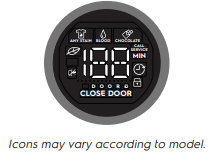
The estimated total cycle time will be displayed when the cycle is selected. The time may increase if water pressure is low, oversudsing occurs or the load becomes unbalanced. The approximate time remaining will be displayed during the cycle. The eco, control lock, close door, mute (some models), and delay time will also appear on this LED display
Eco indicator 
The eco symbol will light up on the LED display to indicate that the selected combination of temperature, spin speed and options are eco friendly
Oversuds protection
A situation where oversudsing has been detected by the washer will result in the washer requiring additional rinses until the suds have been cleared. Each extra rinse the washer performs to clear the suds will add approximately 5 minutes to the cycle duration. The LED will display “SU” followed by “dS” and then the remaining cycle time (0 min) for 60 seconds and then repeat. Press cancel to turn off the alert message. The washer will continue to perform rinse cycles until suds are removed.

Reversed Hose Detection
If condition is detected where the inlet hoses have been installed incorrectly (hot supply to cold inlet and cold supply to hot inlet), the washer will alert you. The LED will display “HO” followed by “SE” and then the remaining cycle time (0 min) for 60 seconds and then repeat. Acknowledge the reversed hose condition by pressing the cancel button. Shut off each water supply valve and attach each supply hose to the correct inlet connection on the washer.

Drum light (on select models)
The drum light will come on whenever the door is opened to illuminate the drum during loading and unloading. Closing the door turns off the light. The drum light will automatically turn off if the door is left open more than 3 minutes.
Reversible door (on select models)
Your washer may be equipped with a reversible door. The door can be hinged on the right or left side.
Trapped item detection
If an item is detected to be trapped between the door and the door gasket, the washer will pause the cycle and play an alert chime. The LED will display a loop of “CLEAr door” as shown below until the cancel button is pressed. Press the cancel button to unlock the door and remove the trapped item, then close the door and restart the cycle.

Door stand ventilation
Help prevent odor buildup and reduce humidity between washes by utilizing your washer’s door stand ventilation feature. Open the door, locate the stand below the door latch and rotate the stand counterclockwise to unlock it.
NOTE If unable to rotate the stand by hand, a coin or flat blade screw driver can be used.
The stand is spring loaded and will extend. Rotate it clockwise to lock in the extended position.
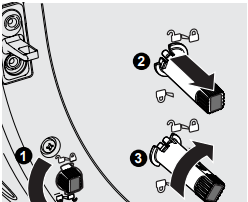
To disengage the stand, rotate to unlock, push the stand in and rotate to lock position.
NOTE If door stand will not turn to locked position, fully turn it to unlock position and try to lock again.
OPERATING INSTRUCTIONS
Operating the washer
WARNING To reduce the risk of fire, electric shock or injury to persons, read the Important Safety Instructions in this Use & Care Manual before operating your washer.
| STEPS | TIPS | IMPORTANT |
|
1. Sort laundry into loads that can be washed together.
|
• Sort by recommended cycle and water temperature. • Separate white, light, and colorfast items from dark and non-colorfast items. • Separate items that shed lint from items that attract lint. Casual, synthetic, knit, and corduroy items will pick up lint from towels, rugs, and bedspreads. • Separate heavily soiled items from lightly soiled items. • Separate lacy, sheer, loosely knit, or delicate items from durable items. |
DO NOT machine wash items containing fiberglass. Small particles of fiberglass left in drum may transfer to fabrics in other loads and cause skin irritation and/or damage to fabrics. DO NOT wash water resistant and water repellent type clothing or other materials. |
|
2. Prepare items for washing.
|
• Empty pockets. • Brush off lint and dirt. Shake out rugs and beach towels. • Close zippers, fasten hooks, button buttons, and tie strings/sashes. Remove non-washable trims and ornaments. • Place delicate and small items (bras, hosiery, etc.) in a mesh bag (not included). |
Mend rips and tears to prevent further damage during washing. Turn knit items inside out to prevent pilling. |
| 3. Pretreat stains and heavy soil. | See stain treatment function in Cycle Options for your particular model or Stain Removal Guide for more information. | |
| 4. Add laundry load to wash tub. |
• Combine large and small items in a load. Load large items first. • Large items should not be more than half the total wash load. • Washing single items is inefficient and may cause an out-of-balance load. Add 1 or 2 similar items to help balance load. • Wash single heavy items (comforter, sleeping bag, etc.) separately. • The washer can be fully loaded, but the items should not be tightly packed. The door should close easily. |
DO NOT overload the washer. DO NOT WASH: Water resistant and water repellent clothing or other materials. |
| STEPS | TIPS | IMPORTANT |
| 1. Add wash products to dispenser. |
• Water conditioners, detergent boosters and enzyme products may be added with detergent. • See Adding Laundry Products for detailed information on the use of the product dispensers. • See Adding Laundry Products for detailed information on the use of various wash products (detergent, bleach, stain treatment, fabric softener, etc). |
Follow manufacturer’s instructions and recommendations when using wash products. Open and close the dispenser drawer slowly. Closing the drawer too quickly could result in early dispensing of the bleach or fabric softener. |
| 2. Select the cycle and settings for the load. |
• See Cycle Selection, Cycle Settings, and Cycle Options for detailed descriptions of cycle controls. • See Cycle Setting Charts to determine which settings are available for each cycle. • To provide the best care, not every setting or option is available with every cycle. If a setting or option is not available for the cycle selected, the indicator will not light. |
Follow fabric care label instructions on items to be washed. Make sure that the PODS® option is selected when using models that have a separate detergent pack compartment. See Adding Laundry Detergent to the Adaptive Dispenser™. |
| 3. Start the washer. |
• Close the door and press start/pause. The washer will not operate with the door open. “CLOSE DOOR” will be displayed as a reminder to close the door. • To add a forgotten item to the washer any time during the wash portion of the cycle, press start/pause. When the door unlocks, open the door, add the item, close the door and press start/pause to resume cycle. • To change settings or options after the cycle has begun, press start/pause, change the settings, and then press start/ pause. If the cycle is not paused first, the unit will emit several beeps when the buttons are pressed but no changes to the cycle will be applied. • To change the cycle once the cycle has begun, press cancel to cancel the cycle, select the new cycle, and press start/ pause to begin the new cycle. Changing a cycle selection without cancelling the current WILL NOT change the cycle. • To cancel a cycle, press cancel. • A signal will sound at the end of the cycle if the chime option is not set to mute. |
DO NOT force door open. As a safety measure, the door will automatically lock during the entire wash cycle. Pause or cancel the wash load to unlock the door. If the cycle is interrupted during spin, the door lock will not release until the tub has stopped spinning. If the water level is above the bottom of the door opening/flexible door gasket, the lock will not release. |
| 4. Remove items from washer when cycle has ended. | • Remove items when the cycle ends and place in dryer, line dry or dry flat as directed on the fabric care label. | Excess wrinkling, color transfer or odors may develop in items left in the washer after the cycle has ended. |
Adding laundry products
Laundry product dispensers
Product dispenser - three compartment dispenser (300 Series)
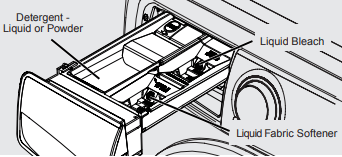
Product dispenser - Adaptive Dispenser™ (400, 500, and 600 Series)
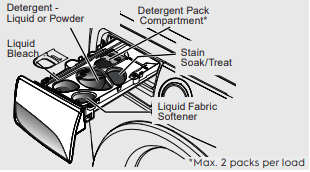
Detergent, stain treatment (on select models), liquid chlorine bleach and liquid fabric softener will be dispensed at the proper times in the cycle.
Use the cap or scoop provided by the detergent manufacturer to measure the amount recommended. Detergent dosage may need to be adjusted for water temperature, water hardness, load size and soil level.
IMPORTANT Open and close the dispenser drawer slowly. Closing the drawer too quickly could result in early dispensing of the bleach or fabric softener.

Adding laundry detergent to the three compartment dispenser
Liquid or powder detergent
- Use the cap or scoop provided by the detergent to add recommended amount of detergent.
- Amount of detergent may need to be adjusted for water temperature, water hardness, load size, and soil level. Follow manufacturer’s instruction.
In a three compartment dispenser use either liquid or powder detergent. DO NOT mix both.
IMPORTANT DO NOT mix liquids and powders.
IMPORTANT DO NOT exceed MAX fill line.
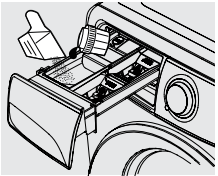
IMPORTANT DO NOT add detergent packs into the three compartment dispenser. Detergent packs should be added directly into the drum.
CAUTION Keep detergent packs away from children.
Adding laundry detergent to the adaptive dispenser™
Liquid detergent
- Use the cap or scoop provided by the detergent to add recommended amount of detergent to the detergent compartment. Pour directly into the detergent cup, not over the blue cover.
- Amount of detergent may need to be adjusted for water temperature, water hardness, and load size. Follow manufacturers instructions.
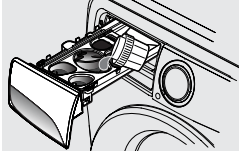
IMPORTANT Pour liquid into the liquid detergent cup. DO NOT pour over the blue cover. DO NOT exceed MAX fill line.
Powder detergent
Remove the liquid detergent cup and blue cover before adding powder detergent.
Add powder detergent directly to the powder detergent compartment.
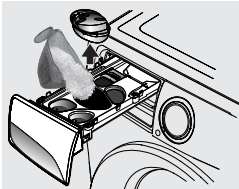
IMPORTANT Save the liquid detergent cup and blue cover for future use. DO NOT discard it while you are using powder detergent. DO NOT exceed MAX fill line.
Detergent pack
For 300 series models
Add detergent pack directly to the empty drum BEFORE placing laundry into the unit.
- DO NOT place detergent packs directly into the detergent drawer. The gel coating may cause the detergent drawer to become clogged.
For 400, 500 and 600 series models
Add the recommended quantity of high efficiency detergent packs to the detergent pack compartment in the dispenser.
- DO NOT place more than two packs into the dispenser.
- When using the fast wash cycle, only one detergent pack should be used.
CAUTION Keep detergent packs away from children.
IMPORTANT
- When using the detergent pack compartment, make sure to select the PODS® option before starting the load.
- Once the PODS® option has been chosen, the washer will retain the PODS® setting until manually changed.
- The washer will ALWAYS use a small amount of HOT water to dissolve the pack when the PODS® option has been selected.
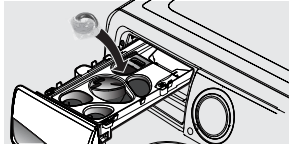
NOTE From time to time you may see water in the dispenser. This is part of the normal operation of the washer.
Adding other wash products
- Color-safe bleach, water conditioner, detergent booster and enzyme products may be added with detergent.
- Put liquid products in the Main Wash - liquid detergent compartment or powder products in the Main Wash - powder detergent compartment.
IMPORTANT DO NOT mix liquids and powders.
Stain treatment (on select models)
- For heavily soiled or stained loads, select the Stain option (on select models only - StainTreat, StainTreatII, or StainSoak) and add the recommended amount of detergent or stain treatment to stain soak/ treat compartment (on select models).
- See Cycle Options for information about Stain options for your model.
- See Stain Removal Guide in this instruction for additional suggestions.
IMPORTANT Use powder detergent in the stain soak/ stain treat compartment for the 400, 500 and 600 Series models with Adaptive Dispenser™.
Liquid chlorine bleach 
- If desired, add liquid chlorine bleach to the compartment labeled Liquid Bleach and marked with this symbol:
 .
. - DO NOT fill above the MAX fill line.
- Add color-safe bleach with detergent.
Liquid fabric softener 
- If desired, pour the recommended amount of liquid fabric softener into the compartment labeled Fabric Softener and marked with this symbol:
 .
. - DO NOT fill above the MAX fill line.
NOTE To prevent staining, DO NOT overfill Fabric Softener compartment or pour liquid fabric softener directly on wash load.
- Use of a fabric softener-dispensing ball is not recommended in front load washers.
CARE AND CLEANING
Inside routine cleaning (preventative)
To help prevent odors or humidity accumulation leave the door open with the door stand ventilation feature (on select models) for a few hours after use or whenever the washer is not in use.
To refresh or clean inside of washer
To clean and freshen the washer, perform the clean washer cycle. For best results perform the cycle once a month.
NOTE Every 50 cycles, your washer will remind you to perform the clean washer cycle by illuminating the clean washer cycle indicator
To begin the cycle, select the clean washer cycle. If installed, remove the LIQUID DETERGENT cup from the dispenser. REMOVE ALL ITEMS FROM WASH DRUM before filling the detergent compartment with one (1) cup of liquid chlorine bleach OR one (1) pouch of TideTM Washing Machine Cleaner. DO NOT use both. Press start/ pause to begin.
IMPORTANT Items left in washer while performing the clean washer cycle will cause a severe out-of-balance situation that could damage the washing machine.
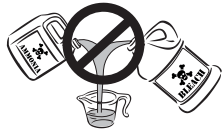
To Clean the dispenser drawer
NOTE Detergent and fabric softener may build up in the dispenser drawer. Residue should be removed once or twice a month.
Cleaning the three compartment dispenser
1. Remove the drawer by pulling the drawer out until it stops.
2. Reach back into the left rear corner of the drawer cavity and press down firmly on the lock tab. Pull out the drawer.

3. Remove all inserts from the drawers.

4. Rinse the drawer and inserts with hot tap water to remove traces of accumulated powders and liquids. Large amounts of fabric softener residue may indicate improper dilution or more frequent cleaning is required.
5. To clean the drawer opening, use a small brush to clean the recess. Remove all residue from the upper and lower parts of the recess.
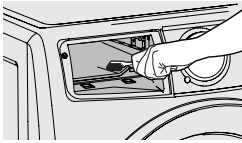
6. Replace the insert by pressing it in place until you hear a slight click.
7. Return the dispenser drawer to the unit.
Cleaning the Adaptive Dispenser™
1. Remove the drawer by pulling the dispenser out until it stops.
2. Reach back into the right rear corner of the dispenser cavity and press down firmly on the lock tab. Pull out the dispenser drawer.
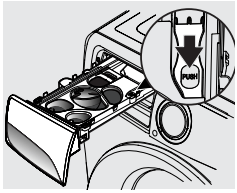
3. Remove the detergent cup and top cover from the dispenser drawer.
4. Remove the bottom cover from the dispenser drawer
a) First, pull the two lock tabs at the rear of the dispenser drawer to unlatch the back cover.
b) Then, gently pull back the two clips on the front of the bottom cover to fully release it from the dispenser drawer.

5. Rinse the dispenser drawer, covers, and detergent cup with hot tap water to remove traces of accumulated powders and liquids. Large amounts of fabric softener residue may indicate improper dilution or more frequent cleaning is required.
6. To clean the dispenser drawer opening, use a small brush to clean the recess. Remove all residue from the upper and lower parts of the recess.
7. Reassemble dispenser drawer and check to ensure that all pieces are securely in place.
8. Return the dispenser drawer to the unit.
Inside cleaning (aggressive)
In cases where clean washer cycle along with care and cleaning of rubber gasket folds isn’t done, and severe odor or residue buildup have developed, follow the below cleaning procedure to help alleviate the problem.
Cleaning procedure-washer drum
Ensure the wash tub is empty. Open the detergent drawer and pour eight cups of bleach into the Main Wash detergent compartment. Select clean washer cycle as described previously in Inside Routine Cleaning (Preventative).
Upon cycle completion inspect the interior of the washer to see if the odor/residue has been eliminated. If any additional cleaning is required, repeat the above procedure. This may take several cycles depending on the severity of the odor/residue. You may observe some remaining discoloration due to the long term effects of this residue.
For especially contaminated areas visible inside the drum (including the front rubber seal), these areas might be more effectively cleaned by spraying a bleach cleaner on a scrub brush, soft sponge, or towel and scrubbing.
IMPORTANT Always wear rubber or latex gloves and protect floor and clothing from damage.
If odor is still left after bleach cycle(s) and bleach cleaner, open the detergent drawer and pour one (1) pouch of TideTM Washing Machine Cleaner in detergent drawer. Select clean washer cycle as above and start the washer.
IMPORTANT See Inside Routine Cleaning for future cleaning maintenance which is necessary to avoid repeating issues.
Three Compartment Preventative Cleaning
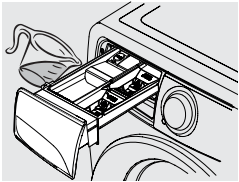
Adaptive Dispenser™ Preventative Cleaning
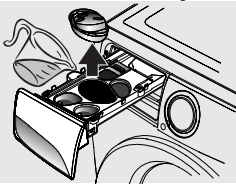
WARNING HARMFUL VAPOR HAZARD DO NOT use or mix liquid chlorine bleach with other household chemicals such as toilet cleaners, rust removers, acid or products containing ammonia. These mixtures can produce dangerous fumes which can cause serious injury or death.
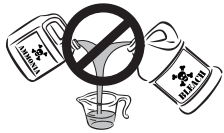
Outside routine cleaning
- When washing is completed, wipe top and sides of washer with a damp cloth.
- Clean the cabinet with mild soap and water. Never use harsh, gritty or abrasive cleansers
- If the cabinet becomes stained, clean with diluted chlorine bleach (1 part bleach to 8 parts water). Rinse several times with clear water.
- Remove glue residue from tape or labels with a mixture of warm water and mild detergent. Or, touch residue with the sticky side of tape.
- When cleaning chrome parts, it is best to use only a damp cloth.
- Before moving the washer, place a strip of cardboard or thin fiberboard under the front leveling legs to prevent damage to the floor.
IMPORTANT DO NOT store or place laundry products on top of washer at any time. They can damage the finish or controls. It is recommended to keep laundry products in the storage drawer between cycles if installed on a pedestal.
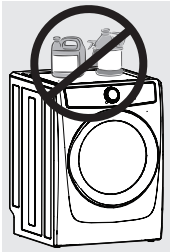
Winterizing instructions
- Turn off water supply faucets.
- Disconnect hoses from water supply and drain water from hoses. Vacuum out each water supply inlet with a waterproof utility vac to ensure water valves are completely drained. Damage will occur if water in water inlet valves are allowed to freeze.
- Plug electrical cord into a properly grounded electrical outlet.
- Add 1 gallon (3.8 L) nontoxic recreational vehicle (RV) antifreeze to empty wash drum. Close door.
- Select any cycle. Press start/pause and let the washer drain for 1 minute to drain out all the water. Not all of the RV antifreeze will be expelled.
- Press cancel, unplug electrical power cord, dry off drum interior and close door.
- Remove dispenser drawer. Drain any water in compartments and dry compartments. Replace drawer.
- Store washer in an upright position.
- To remove antifreeze from washer after storage, run empty washer through a complete cycle using detergent. DO NOT add wash load.
IMPORTANT If the washer is stored in an area where freezing can occur or moved in freezing temperatures, follow these winterizing instructions to prevent damage to the washer:

TROUBLESHOOTING
Common washing inquiries
Many washing problems involve poor soil and stain removal, residues of lint and scum, and fabric damage. For satisfactory washing results, follow these suggestions provided by The Soap and Detergent Association.
| PROBLEM | POSSIBLE CAUSES | SOLUTIONS | PREVENTIVE MEASURES |
| Blue stains | • Undiluted liquid detergent or fabric softener dispensed directly onto fabric. |
• If caused by detergent, mix 1 cup (240 ml) white vinegar with 1 qt (.95 L) water in plastic container. Soak 1 hour. Rinse. • If caused by fabric softener, rub stains with bar soap. Wash. |
• Avoid overfilling detergent and fabric softener compartments of dispenser. |
| Discoloration, graying |
• Not enough detergent. • Wash water temperature too low. • Incorrect sorting. |
• Rewash with correct amount of detergent and hottest water safe for fabric. • Add bleach safe for fabric. |
• Sort items by soil level and color. • Use correct amount of detergent, hottest water and bleach safe for fabric. |
| Greasy, oily stains |
• Not enough detergent. • Undiluted liquid fabric softener poured directly on fabric. |
• Treat with prewash stain remover or liquid detergent. • Increase detergent and water temperature. Rewash. • Rub fabric softener stains with bar soap. |
• Use correct amount of detergent and hottest water safe for fabric. • DO NOT pour liquid fabric softener directly on fabric. |
| Holes, tears, or snags |
• Incorrect use of chlorine bleach. • Unfastened zippers, hooks, buckles. • Rips, tears and broken threads. • Overloading washer. • Degradation of fabric. |
• May be irreversible if rips, tears and seams cannot be mended. |
• Never pour chlorine bleach directly on fabric. • Check condition of items before washing. |
| Lint |
• Incorrect sorting. • Tissues left in pocket. • Overloading washer. • Not enough detergent. • Undissolved detergent has left a residue resembling lint. • Static cling is attracting lint. • Load washed too long. |
• Reduce load size. Rewash using correct water temperature, water level, and amount of detergent. • Add nonprecipitating water conditioner to wash water to remove detergent residue. • Add liquid fabric softener to final rinse. • Dry load in dryer. • Remove lint with lint brush or roller. |
• See Operating Your Washer. • DO NOT overload washer. • Use correct temperature and amount of detergent, water and wash time. |
| Pilling (Fibers ball up and cling to fabric.) | • Pilling is normal with synthetic and permanent press fabrics. This is due to abrasion from normal wear. | • Use a lint brush or shaver to remove pills. |
• Use fabric softener in washer to lubricate fibers. • When ironing, use spray starch or fabric finish on collars and cuffs. • Turn items inside out to reduce abrasion. |
| Residue or powder on dark items; Stiff, harsh fabrics. |
• Undissolved detergent. • Some granular detergents can combine with hard water minerals to form a residue. • Overloading washer |
• Rewash load. |
• Increase water temperature using hottest water safe for fabric. • DO NOT overload washer. • Use liquid detergent or nonprecipitating water conditioner with powder detergent. |
| Wrinkling |
• Overloading washer. • Incorrect wash cycle for wash load. |
• Reduce load size. • Rinse in cold water with liquid fabric softener using the casual or delicate cycle. |
• DO NOT overload washer. • Remove items from washer as soon as cycle is completed. • Use liquid fabric softener |
| Yellow buildup of body soil on synthetic fabrics |
• Agitation time too short. • Wash water temperature too low. • Not enough detergent. |
• Soak in detergent booster or product containing enzymes. • Wash in hottest water safe for fabric using casual cycle. • Increase detergent. • Add bleach safe for fabric or treat with color remover. |
• Select correct cycle. • Use correct amount of detergent. • Wash synthetics frequently using hot or warm water. |
| Yellow or brown rust stains | • Iron or manganese in water supply, water pipes, or water heater. |
• To restore discolored load of whites, use rust remover safe for fabric. • DO NOT use chlorine bleach to remove rust stains. It may intensify discoloration. |
• Use nonprecipitating water softener. • Before washing, run hot water for a few minutes to clear lines. • Drain water heater occasionally. • For an ongoing problem, install an iron filter in your water supply system. |
| Residue stain buildup in gasket |
• Moisture in washer. • Use of non-HE detergent. • Overdosing detergent. • Overloading wash drum. • Leaving a wet load set in washer. • Cold water washes which may not completely dissolve and remove detergents. |
• Perform clean washer cycle • Scrub gasket with Comet™ Spray Gel Mildew Stain Remover - use brush to remove stains. • Use only HE (high efficiency detergent) along with recommended dosage. • Remove wash load immediately upon cycle completion. |
• Run dehumidifier in laundry room. • Avoid overfilling detergent and fabric softener compartments of dispenser. • Dry the inside of washer and gasket after every run. |
| Residue stain buildup in dispenser drawer or detergent pack not dissolved. |
• Moisture in the washer. • Use of non-HE detergent. • Overdosing detergent. • Adding more than two detergent packs to detergent pack compartment. • PODS® option not selected when using detergent pack (on select models). |
• Remove and clean dispenser and inserts with combination of ¾ cup liquid chlorine bleach and one gallon hot water. Rinse well, and repeat if necessary. NOTE: Wear rubber of latex gloves. Protect floor and clothing from bleach damage. • Use only HE (high efficiency detergent) along with recommended dosage. |
• Avoid overfilling detergent and fabric softener compartments of dispenser. • Check that PODS® option is selected and detergent pack is placed in PODS® dispenser compartment when using detergent pack (on select models). |
| Water in fold of flexible gasket | • Result of washing and part of normal operation. | • At the end of each wash, dry inside of gasket fold with clean dry towel all around gasket. | |
| Odor |
• Moisture in the washer. • Use of non-HE detergent. • Overdosing detergent. • Leaving a wet load remain in washer. • Cold water washes which may not completely dissolve and remove detergents. |
Perform clean washer cycle. • At the end of each wash, dry inside of gasket fold with clean, dry towel all around gasket. • Use only HE (high efficiency detergent) along with recommended dosage. • Remove wash load immediately upon cycle completion. • Pour one cup liquid chlorine bleach in standpipe; let remain a day and flush with water |
• Utilize the door stand ventilation feature for a few hours after use or whenever washer is not in use. |
Before calling
Before calling for service, review this list. It may save both time and expense. The list includes common occurrences that are not the result of defective workmanship or materials in this washer.
| PROBLEM | POSSIBLE CAUSES | SOLUTIONS |
| NOISE (Please refer to Normal Operating Sounds) | ||
| High pitch “jet engine” noise | • A certain amount of motor whine is normal during the spin cycle. | |
| Rattling and clanking noise |
• Foreign objects such as coins or safety pins may be in drum or pump. • Belt buckles and metal fasteners are hitting wash drum. |
• Stop washer and check drum. If no objects are found, perform cycle with empty drum. If noise continues, item may be in pump. Call your authorized service technician. • To prevent unnecessary noise and damage to drum, fasten fasteners and turn items inside out. |
| Thumping sound | • Heavy wash loads may produce a thumping sound. This is usually normal. If sound continues, washer is probably out of balance. | • Stop washer and redistribute wash load. |
| Vibrating noise |
• Washer is not resting firmly on floor. • Shipping bolts and foam block have not been removed during installation. • Wash load unevenly distributed in drum. |
• Move washer so it rests firmly on floor. Adjust leveling legs. See Leveling the washer for details. • See Installation sections of this manual for removing shipping bolts and foam block. • Stop washer and rearrange wash load. |
| OPERATING | ||
| Residue left in drum | • Heavily soiled items. | • Wipe drum with a nonabrasive household cleanser, then rinse. Shake or brush excess dirt and sand from items before washing. |
| LED displays “dn” | • Washer has been programmed to temporarily perform a repeating demo cycle. |
• Reset the unit back to factory default settings. 1. Press power to turn off unit. Press power again to turn unit on. Look for console to light up. 2.Wait at least 10 seconds, then simultaneously press and hold soil and options buttons for 3 secs. 3.Lights will turn OFF and ON, indicating the unit has been reset to factory default |
| Washer won’t spin | • Load is too small. | • Add 1 or 2 similar items to help balance the load. |
| LED Displays “CLEAr door” | • Washer has detected something trapped between the door and door gasket. | • Press the cancel button to unlock the door, remove the trapped item, close the door and restart the cycle. |
| Washer does not start |
• Electrical power cord may not be plugged in or connection may be loose. |
• Make sure plug fits tightly in wall outlet. |
| • House fuse blown, circuit breaker tripped, or a power outage has occurred. | • Reset circuit breaker or replace fuse. DO NOT increase fuse capacity. If problem is a circuit overload, have it corrected by a qualified electrician. If problem is a power outage, call local electric company. | |
| • Action of pressing start/pause button on “touch screen” style console not recognized. | • Press start/pause button with bare fingertip | |
| • Water supply faucets are not turned on. | • Turn on water supply faucets. | |
| • Motor is overheated. Washer motor will stop if overheated. | • It will automatically restart after a cool down period of up to 30 minutes (if washer has not been manually turned off). | |
| • Door may be open. Unit will not operate with door open | • Ensure door is closed. | |
| • Light next to start/pause button is flashing indicating unit is paused. | • Press start/pause button to continue the cycle. | |
| WATER | ||
| Water collects in folds of the door gasket at the end of the cycle | • This is a result of the washing action and is part of the normal operation of the washer. | • Wipe and dry the gasket to remove water and any debris remaining in the gasket after use. |
| Water collects in bleach and fabric softener compartments | • This is a result of the siphoning action and is part of the normal operation of the washer. | • Water may be removed by removing the dispenser drawer (see Care and Cleaning in this manual) and draining water into the empty drum or sink. |
| Wash load too wet after spin |
• Washer is overloaded.
• Load is too small.
• Load is out of balance.
• Drain hose is kinked. |
• DO NOT overload washer. See Operating Your Washer. • Add 1 or 2 similar items to help balance load. • Rearrange load to allow proper spinning. • Straighten drain hose. |
| Water does not enter washer or it enters slowly |
• Water supply is not adequate in area. • Water supply faucets are not completely open. • Water is being used elsewhere in the house. Water pressure must be at least 30 psi (260 kPa). • Water inlet hoses are kinked. • Water inlet screens plugged. |
• Check another faucet in the house. Wait until water supply and pressure increase. • Fully open hot and cold faucets. • Avoid running water elsewhere while washer is filling. • Straighten hoses. • Remove hose from inlets and clean screens. |
| Warm or hot water is not hot enough |
• Hot water heater is set too low or is a distance from washer. • Hot water is being used elsewhere in the house. |
• Measure hot water temperature at nearby faucet with candy or meat thermometer. Water temperature should be at least 120°F (49°C). Adjust water heater as necessary. • Avoid using hot water elsewhere before or during washer use. There may not be enough hot water available for proper cleaning. If problem persists, your hot water system may be unable to support more than 1 use at a time. |
| Water in washer does not drain or drains slowly |
• Drain hose is kinked or clogged. • Drain hose standpipe is too tall. Maximum standpipe height is 8’ (2.4 m). • House drain pipes are clogged. |
• Clean and straighten the drain hose. • Reduce standpipe height to less than 8’ (2.4 m). See Installation sections of this manual. • Unclog drain pipes. Contact plumber if necessary |
| Water leaks |
• Fill hose connection is loose at faucet or washer. • Dispenser drawer not completely closed • Water hoses have damage, cuts or corrosion. |
• Check and tighten hose connections. Install rubber sealing washers provided. • Close dispenser drawer completely. • Replace hoses. |
| Oversudsing |
• HE detergent is not being used. • Too much detergent. |
• Run rinse cycle. Use a lowsudsing, high efficiency detergent. • Run rinse cycle. Use less detergent in future loads. |
| Incorrect wash and rinse temperatures. The LED display will alert this condition with “HOSE” alarm | • Hot and cold water hoses are connected to wrong supply faucets. | • Connect hot water hose to hot water faucet and cold water hose to cold water faucet. |
| Water is entering washer but tub does not fill | • Drain hose standpipe is too low. Standpipe must be a min of 23.6” (60 cm) high to prevent siphoning. | • Increase standpipe height to at least 23.6” (60 cm). See Installation sections of this manual. |


